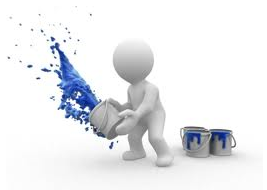Web developers are always taught to abide by web safe colors, but few people truly understand what the term ‘web safe colors’ means, nor what COLORS are good for WEB DESIGN. So how important are colors in web design, really?
“Web Safe” Colors
The idea of ‘web safe colors’ was introduced when computer graphic cards were still in their infancy, and could not handle the full color palette available. The original pallet was 216 colors that worked on both PCs and Macs, so websites would work no matter the platform. However, with the advancement of technology, this is no longer necessary – using the old palette will create a nostalgic effect, but the site will look dated and old fashioned.
Modern Graphics
The modern palette of 256 colors is used across all platforms, as both graphics cards and monitors have improved. In fact, web sites can be viewed in around 16.7 MILLION colors, so the old restrictions are no longer valid. Color is still important to take into consideration, though, because of what it can be used for. A skilled web designer can use color to evoke certain feelings and emotions; for instance, a page about hope and living a joyful life, the color yellow could be used. In a site meant to evoke sadness, or prompt you to take action for a good cause, a light blue could be used. Knowing how to combine colors and use them to get the results you desire will greatly improve the quality of a website.
Color Theory
This idea is called color theory, and is the single reason that colors are vitally important in web design. A rule of thumb to follow is that every color on your website must have a purpose, just as every word in your copy must have a purpose. Superfluous colors should be removed; if you think it looks nice, but has no other effect, then replace it with one that does. However, looking nice can be an effect in and of itself; the combination of colors to create a pleasing effect is often used on marketing and retail websites. Relaxing the consumer and making them feel at ease in purchasing is a trick many retailers use, and one so subtle that most people aren’t aware that it is happening. While there is a lot of disagreement on what colors mean what, the standards are simple. Red is used to denote power and passion, and to create a feeling of excitement. Orange, like yellow, is used to denote happiness, but carries the negative connotations of trickery with it. Yellow can be used to symbolize both joy and caution. Green is easy: it symbolizes life, growth, and new beginnings. Blue is used to calm, where as purple is used to give a feeling of luxury. Black can denote both elegance and sorrow, while white denotes safety and sterilization.
While the original ‘web safe’ palette is no longer needed, colors are still vastly important in web design. With purposes that range from evoking emotion to simply making a website aesthetically pleasing, the proper use of WEB DESIGN COLORS can make a website stand out above all others, and should be a standard part of any designer’s skill set.
For more information, check out “Colors by Culture“.
 Follow
Follow
